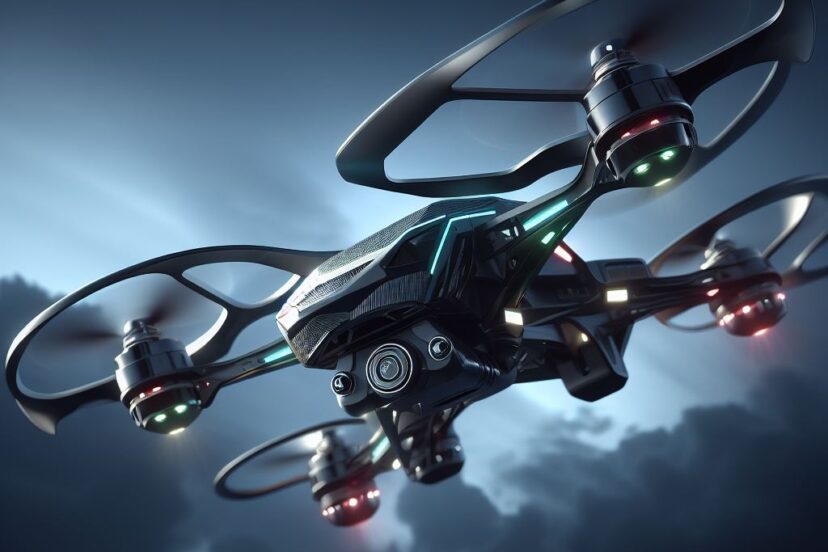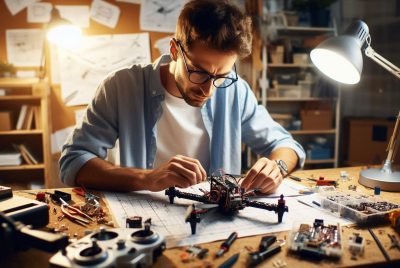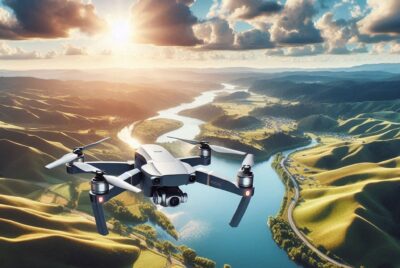Stunt Drone: Aerial Acrobatics Unleashed
*We may earn a commission for purchases made using our links. Please see our disclosure to learn more.
Stunt Drone Mastery: Elevate Your Flying Skills
Stunt drones, a dynamic facet of the drone market, have grown in popularity as technology has advanced. Their agility and capability have expanded, allowing for remarkable aerobatics that capture the imagination of hobbyists and professionals alike. My experience with drones underscores that stunt drones are specially designed for performing intricate maneuvers such as flips, rolls, and spins, which standard drones are typically not built to handle. These maneuvers are not just for show; they require precision and technical sophistication that highlight the drone’s engineering quality and the pilot’s skill level.

I’ve noticed that the selection of stunt drones has become quite diverse, catering to a wide range of users from beginners to seasoned aerial acrobats. They come equipped with features like gravity sensors, altitude hold, and headless mode that facilitate ease of control and stability during flight. Whether I’m looking for a drone that is lightweight and easy to maneuver like the Cheerwing CW4, or one that stands out for its long flight time like the JJRC H68, the current market offers something that fits my needs.
Moreover, the stunt drone community has been a critical driver for innovation in this field. Their feedback and experiences often lead to meaningful advancements in drone technology. While engaging with drones, I’ve learned that comprehensive reviews and hands-on testing are invaluable in determining the right drone for performance and value. The market has grown savvy, focusing on quality parts and reliable performance over mere brand name appeal. This directly benefits consumers by elevating the industry standards and ensuring that even drones that are more accessibly priced do not compromise on capability or durability.
Understanding Stunt Drones

In my exploration of stunt drones, I’ve noticed they combine excitement with advanced technology. They’re designed for both fun and agility, suitable for indoor or outdoor use, depending on their build and features.
Fundamentals of Stunt Drones
Stunt drones, as the name suggests, are built specifically for performing aerial acrobatics and maneuvers. Unlike standard camera drones, which prioritize stability and clear imagery, stunt drones focus on nimble movements and fast-paced flying. A key fundamental of these drones lies in their responsive controls and enhanced maneuverability. They usually have a 6-axis gyro which significantly aids in their acrobatic capabilities, enabling flips and rolls with ease.
Most stunt drones come with different flight modes. For beginners, there’s often a stability mode that simplifies control, while advanced pilots can use a more agile mode to execute complex stunts. Remote control is standard, with most offering a range of channels; 4 channels (4 CH) being common. This means control over lift, yaw, pitch, and roll.
Key Features of Stunt Drones
When considering key features, battery life and flight time are crucial—typically, you can expect anywhere between 5 to 15 minutes of airtime, depending on the model and battery used. Fast battery recharge times and extra batteries can prolong the flying experience. Additionally, many models come with different speeds, which means I can adjust the speed to suit my skill level or the space I’m flying in.
The best stunt drones may come with a camera, often HD, that’s either fixed or adjustable, although for advanced aerial photography, a 4k camera with an anti-shake feature would be more desirable. While camera quality isn’t the main focus for a stunt drone, it’s a plus for those who enjoy recording their stunts. As for the control distance, depending on the drone’s purpose, it could range from a few meters for indoor toys to over a kilometer for outdoor, more advanced models.
Durability is also pivotal, as stunt drones are prone to crashes. Look for durable materials and protection guards. For those that value portability, a foldable design is a great feature that doesn’t compromise drone integrity. Brushless motors are typically found on higher-end models and provide better durability and power efficiency.
Advanced features like GPS, return to home, and follow me mode are usually found in drones that blur the line between stunt and camera drones. An example is the DJI FPV, which combines fast, acrobatic performance with the ability to capture smooth video, providing both stunt capabilities and videography tools.
Regardless of the feature set, each drone has a specific target audience and use case scenario, from casual indoor flyers to enthusiasts capturing their outdoor stunts with an onboard camera.
Stunt Drone Control Techniques

In the realm of aerial acrobatics, mastering drone control techniques is essential for both safety and performance. I’ll discuss the crucial controls and how to execute basic and advanced drone stunts with precision.
Basic Maneuvers and Controls
My experience with drones has taught me that understanding the basics is vital before attempting any stunts. Here are some fundamental controls:
- Throttle: Adjusts altitude.
- Yaw: Rotates the drone left or right.
- Pitch: Moves the drone forward or backward.
- Roll: Tilts the drone side to side to move it left or right.
For stability and ease of control, many drones, like the Hubsan X4, offer features such as headless mode, where the forward direction relates to the remote control, no matter the drone’s orientation. Altitude hold maintains a consistent altitude, allowing me to focus on directional control. Here’s a quick list of maneuvers that exploit these controls:
- Hovering: I maintain a steady altitude and position, a fundamental skill for all stunts.
- 360° flips: I perform these by inputting a specific command or gesture control, depending on the drone model. Most drones with a stunt mode or expert mode have one-touch controls for 360° flips.
Essentially, these maneuvers rely heavily on manual dexterity and familiarity with the LCD screen and remote control feedback.
Advanced Stunt Performance
Upon mastering basic controls, I proceed to advanced stunts which require agility and precise timing. Here are the techniques I’ve honed over time:
- Barrel rolls: A complex maneuver where I flip the drone on its axis while moving forward, needing precise throttle and roll input.
- Advanced flips: Beyond the basic 360° flip, I execute these at high speeds or combine them with other maneuvers for a dynamic performance.
Advanced stunts typically exploit the full range of drone acrobatics, and most of these are facilitated by a drone’s stunt or expert mode, where the sensitivity of the controls is increased for greater agility. When I aim for these stunts, I ensure that the drone has enough speed and stability to maintain control during the execution.
Proper execution of these stunts comes down to a combination of precise control inputs and understanding the drone’s behavior. Gesture control can also add a dynamic element to stunt performance, allowing me to command the drone with hand movements.
Selecting Your Stunt Drone

When I look for a stunt drone, I focus on models that combine durability and maneuverability, ensuring each flight is both thrilling and safe. It’s essential to consider the drone’s features relevant to your skill level and performance needs.
Drones for Beginners and Hobbyists
For those new to drone flying, I recommend starting with a drone that has beginner mode settings, like the Syma X5C-1 or the Hubsan X4 Quadcopter. These models are typically more affordable and designed to withstand the inevitable bumps and crashes. They offer a mix of stability and ease of control, with features such as headless mode and altitude hold, which help maintain a stable flight.
- Durability: Beginner drones are often built with resilience in mind, to outlast crashes.
- Features for Stability: Look for drones with wide-angle camera settings for better spatial awareness and RGB lights for improved visibility.
Racing and High-Performance Drones
For drone enthusiasts aiming for speed and advanced maneuvers, racing drones like the DJI Mavic Air are a strong choice. These drones are usually more powerful and lightweight, enhancing their agility for complex aerial stunts such as 360° flips. Racing drones often come with advanced mode features for experienced pilots, including:
- Obstacle Avoidance: This is crucial for avoiding collisions at high speeds.
- Advanced Controls: Sophisticated systems like voice control give you an edge in maneuverability.
Racing Drone Specifications:
| Drone Model | Weight | Feature | Suitable For |
| DJI Mavic Air | Light | Obstacle avoidance | Advanced user |
| Potensic F181DH | Medium | Durable and stable | Beginners |
In conclusion, whether I’m advising a beginner or a seasoned racer, I always suggest looking for drones that are tailored to the pilot’s current ability while offering room to grow with their skills. Consider the drone’s weight, control features, and durability before making your purchase.
Stunt Drone: Safety and Regulations

In piloting stunt drones, I prioritize safety and adherence to legal frameworks. My engagement with stunt drones encompasses ensuring operational safety features and understanding the varying legal considerations, as both aspects are critical.
Safety Features and Precautions
I always start with a pre-flight checklist to ensure all safety features are active and functioning. This includes LED lights and propeller guards, which are essential for visibility and protection. Features like GPS and altitude hold contribute to stability during complex maneuvers. For instance, when performing flipping stunts, these features help me maintain control and prevent crashes. Additionally, I make it a habit to conduct stunts in open areas, away from obstacles, using drones with obstacle avoidance systems for an additional layer of safety.
- Indoor Safety: When flying indoors, I remain cautious of enclosed spaces and potential for interference with my drone’s controls.
- Outdoor Safety: In outdoor environments, I prefer locations devoid of crowds and ensure I maintain a clear line of sight to my drone.
Legal Considerations for Flying Stunt Drones
To legally operate a stunt drone, I stay informed about the regulations that apply to my location. The weight of the drone often dictates the category under which my drone falls, necessitating specific regulatory compliance. For example:
- Drones weighing over 250 grams: I register my drone and display the FAA identification number on the chassis.
Given the varying regulations, I consistently consult local aviation authorities to stay updated. I am aware that different countries may have unique requirements regarding where I can fly, potential no-fly zones, and altitude limits. These regulations not only protect privacy and prevent disruption but also ensure airspace safety for all users.
By combining safety features with legal vigilance, I ensure a responsible and enjoyable stunt drone flying experience.
Stunt Drone Maintenance and Accessories

In this section, I will cover the essentials of keeping your drone in top condition and the exciting upgrades that can enhance your flying experience.
Caring for Your Drone
Regular Maintenance: My routine for drone care begins with checking for damage before and after flights, focusing on propeller health and ensuring the motor runs smoothly. I advise investing in a maintenance kit that typically includes a propeller puller and screwdrivers. Use of brushless motors can reduce wear over time, offering me more durable and longer-lasting performance.
Battery Care: I am meticulous about battery upkeep because proper charge cycles extend battery life. It is vital to store batteries at an optimal temperature and to charge them fully before use. Most drones, such as the DJI FPV or the Potensic F181DH, come with specific battery instructions that I follow closely to maximize efficiency.
Enhancements and Upgrades
Performance Accessories: When I’m looking to boost the speeds and agility of my drone for stunts like 360° flips and 3D flips, I consider installing higher-capacity batteries and advanced propellers. The Skydio 2 and Yuneec Mantis G are models that are already equipped with powerful features, but even they can benefit from fine-tuning with accessories such as propeller guards and additional RGB lighting for visibility.
Camera and Sensory Upgrades: For enhancing video recording and camera quality, I recommend wide-angle or anti-shake cameras. Some drones come with built-in obstacle avoidance systems, and upgrading to these can improve piloting. The DJI Mavic Air, renowned for its camera capabilities, can be a significant game-changer for anyone interested in aerial photography, providing that distinct clarity and stability.
I ensure that any accessories I add, like portable carrying cases or additional protective gear, don’t impede the drone’s functionality—especially its flipping capabilities. Ensuring the added parts are compatible with the 6-axis gyro is also crucial as it maintains the balance and stability necessary for performing intricate maneuvers, like the boomerang or fury flip.
FAQs About a Stunt Drone
In my experience with stunt drones, I’ve encountered a range of questions from beginners to seasoned professionals. Below are answers to some of the most frequently asked questions to help you better understand stunt drone capabilities and features.
1. How can I perform flips and stunts with a stunt drone?
Performing flips and stunts with my drone typically involves a combination of specific control inputs. Most drones capable of stunts have a dedicated button or function in their controller software that allows me to execute a flip with a single press. I ensure the drone is at a sufficient altitude before attempting any such maneuvers to prevent any accidental crashes.
2. What are the camera specifications for a high-quality stunt drone?
A high-quality stunt drone usually features an HD camera with at least a 720p resolution. I look for cameras that can record at a high frame rate, such as 60fps, to capture smooth footage during fast movements. Some of the best drones also come with image stabilization to reduce blur during stunts and tricks.
3. What are the best apps for controlling a stunt drone?
The best apps for controlling a stunt drone provide a user-friendly interface and responsive controls. I have used apps like DJI GO 4 and Tello for drones from respective brands. These applications often include features for automatic takeoff and landing, stunt execution, and live video feed viewing.
4. What should I look for in an FPV stunt drone?
When looking for an FPV (First Person View) stunt drone, I pay attention to the field of view (FOV) of the camera, latency of the video transmission, and the responsiveness of the controls. A wider FOV helps me with spatial awareness during flights, while low latency ensures real-time feedback, which is crucial for performing precise maneuvers.
5. Where can I find instructions for my new Sharper Image stunt drone?
For a new Sharper Image stunt drone, I generally find the instructions in the included user manual. In case I need additional resources, the manufacturer’s website or customer support can be helpful. Many companies also offer tutorial videos and troubleshooting guides online.




